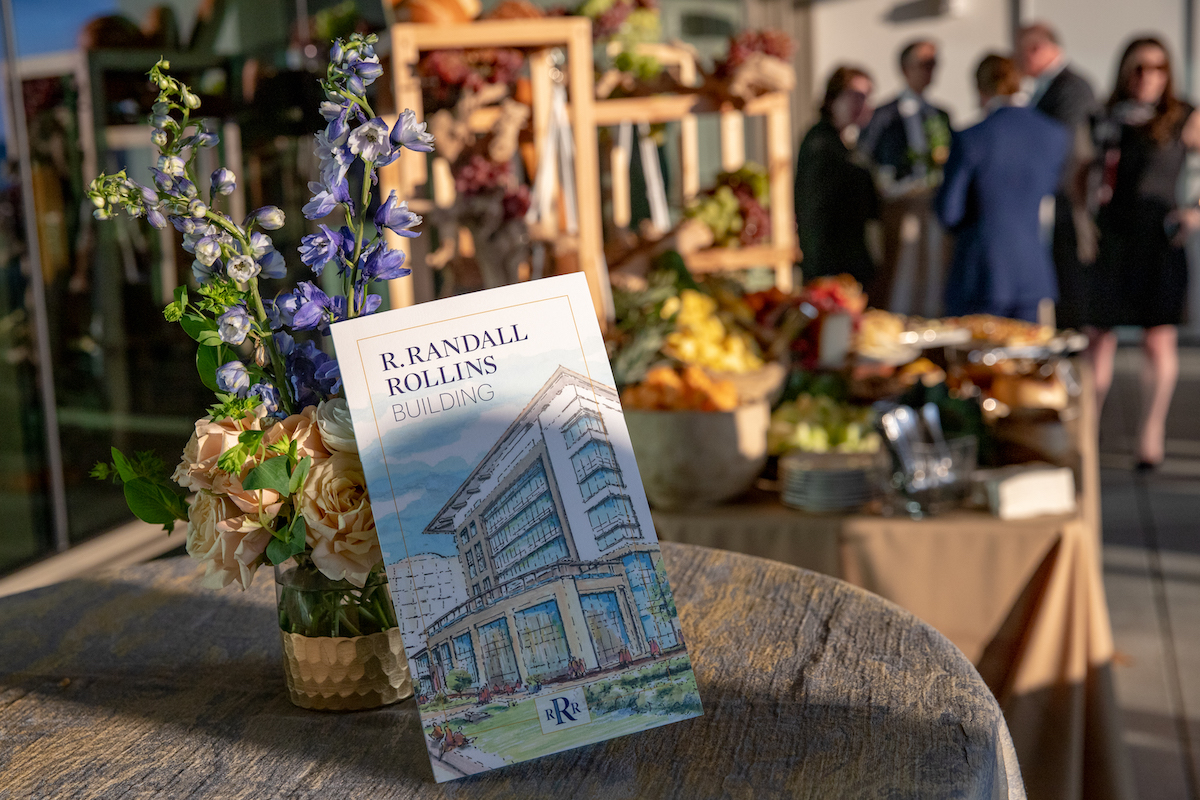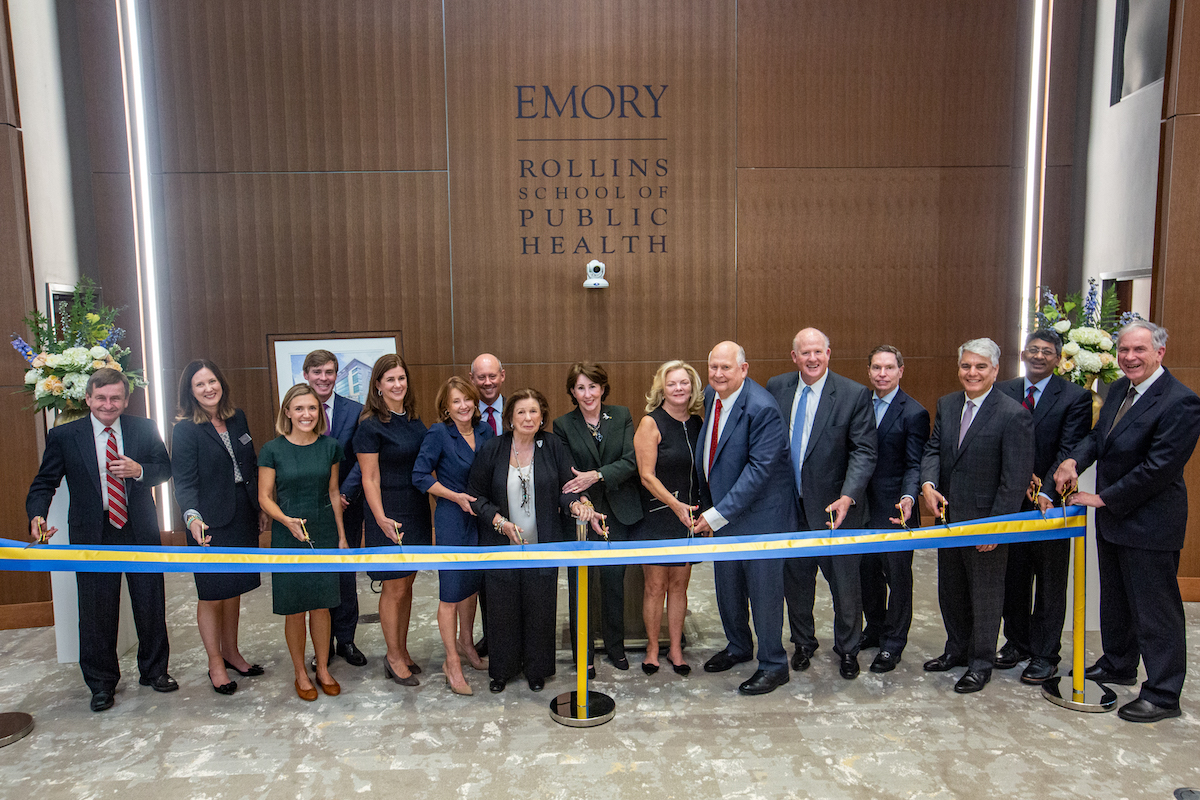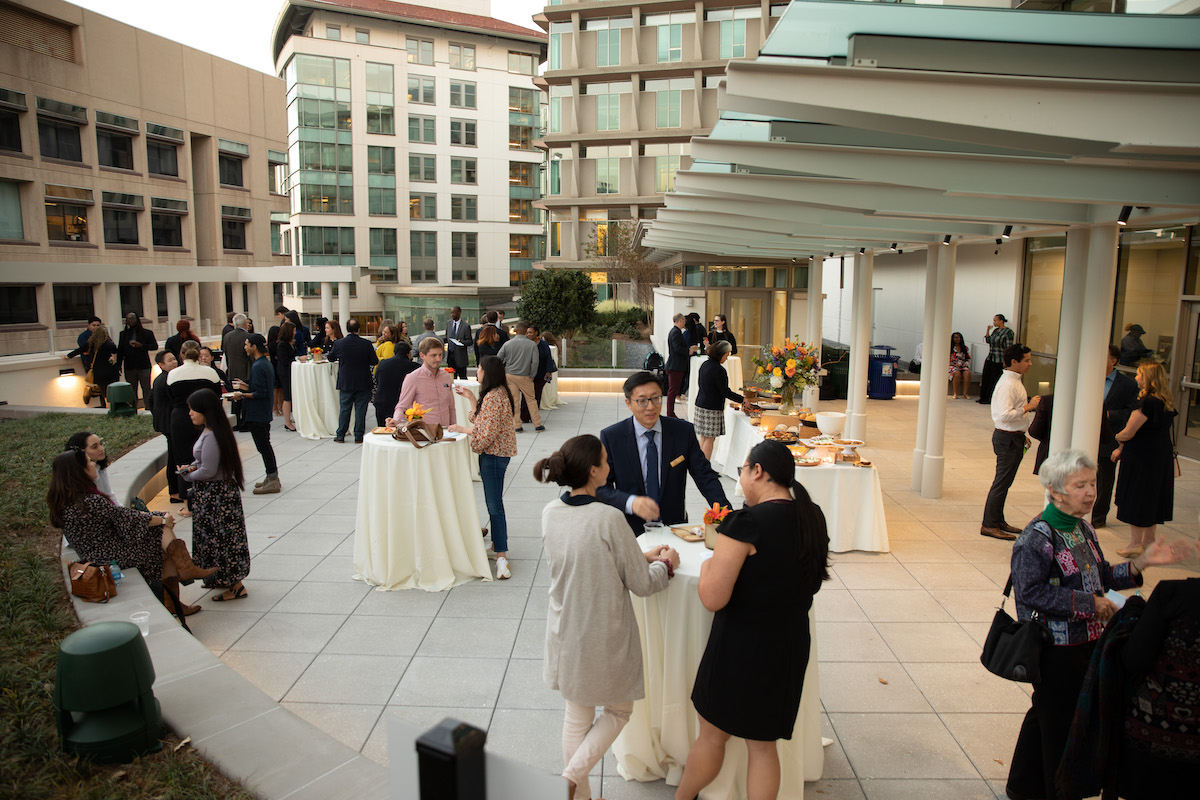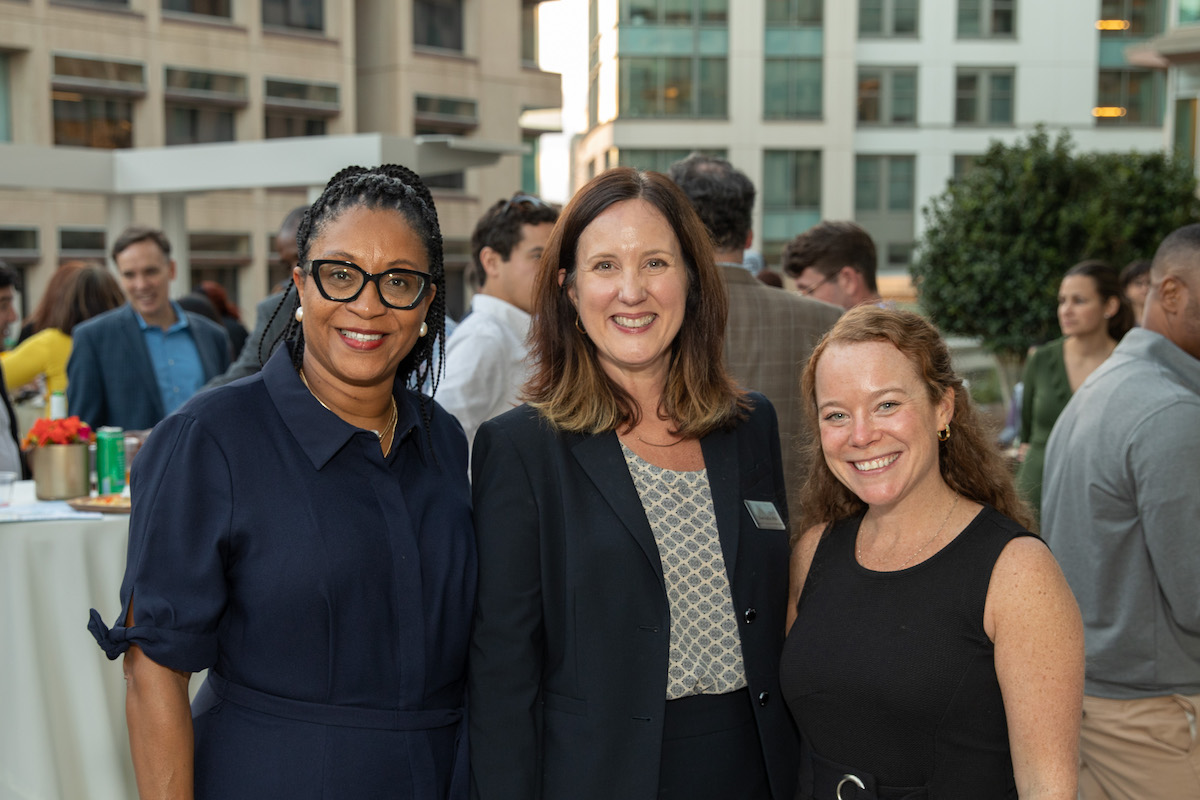It was a warm, blue-skied day with Emory’s campus flaunting peak fall colors when droves of students, faculty, staff and friends gathered for the long-anticipated dedication and ribbon-cutting ceremony for the R. Randall Rollins Building. Attendees gathered in the radiant Margaret H. Rollins Room, on the plaza level of the new building (named in honor of Randall Rollins’ wife), with additional guests watching the event in two overflow spaces and via a live stream.
Robert C. Goddard, III, chair of Emory’s Board of Trustees, presided over the event, which included remarks from Gregory L. Fenves, president of Emory University; David S. Stephens, interim executive vice president for health affairs; M. Daniele Fallin, James W. Curran Dean of Public Health; Sabrina Chow, current student; James W. Curran, emeritus dean of public health and professor of epidemiology and global health; Stephen D. Clements, R. Harold Harrison Distinguished Professor of Cardiology; and Michael M. E. Johns, Michael M.E. Johns Distinguished Professor of Health Policy, emeritus executive vice president for health affairs, and emeritus president and CEO of Emory Healthcare.
Goddard, Curran, Clements and Johns all shared personal reflections on Randall’s legacy and his influence on their lives and on public health.
“From its conception 32 years ago, the Rollins School of Public Health has played a powerful role in educating students and advancing innovative research to address some of the most challenging and critical public health issues facing Georgia, the nation and regions around the world, and literally improving the lives of millions and millions of people,” Fenves said.
Stephens added to these sentiments, remarking on the tremendous growth and influence of the school. “The name Rollins is now globally synonymous with preeminence in public health from our city, state, nation and across the world ... people associate the name Rollins with changing lives,” he said.
A tribute video to the late Randall Rollins — which included reflections from his brother, children and Curran — elicited an emotional response from the crowd. Following an emblematic ribbon-cutting, which included university leaders and members of the Rollins family, attendees took tours of the building and enjoyed music, light appetizers and drinks on the second-floor terrace and in the first-floor lounge area.
The R. Randall Rollins Building joins sister structures, the Grace Crum Rollins and Claudia Nance Rollins buildings, to compose the substantial physical footprint of the Rollins School of Public Health, which now encompasses 500,000 square feet.
This new facility, like those before it, will serve to foster the unique sense of community and purpose shared by the students, faculty and staff of Rollins as they continue to work toward the school’s shared mission of improving the world’s most pressing public health issues through learning, collaboration and research.
“In this year of many milestones for our school, the opening of the R. Randall Rollins Building stands out for its significance, because the building exemplifies the collective spirit of our school,” Fallin said.
Building highlights
Spanning a whopping 185,000-square-feet, the 10-floor R. Randall Rollins Building is radiant with natural light, thanks to illustrious usage of glass. Constructed by New South Construction and designed by The S/L/A/M Collaborative, the building is LEED Gold Certified. Work spaces are conducive to a variety of working styles, with open-floor office spaces, collaborative meeting rooms and private offices that will be occupied by a variety of the school’s service units and academic departments.
Visitors can access the building through the ground level entrance on either the Michael Street or Clifton Road sides, or through an interior bridge on the first floor of the Grace Crum Rollins Building.
The building brings 10 new classrooms to the school — located on the lower level, and floors one, two and three — that range in capacity from 24 to 120, as well as multiple areas for studying, training and congregating. Dancing Goats coffee shop and adjacent lounge has made a home on the first floor, next to the bridge, and an expansive reading room and outdoor terrace on the second floor invite opportunities for quiet study and meaningful connection.
The spectacular Margaret H. Rollins Room makes a home on the plaza level and seats up to 250 for special events, while an eighth-floor event space seating 115 mirrors that of the Claudia Nance Rollins Building with a terrace and Atlanta city views. An additional training space on the eighth floor seats 48 and lends itself to a variety of workshops and training opportunities to members of the Rollins community, partners and the public health workforce.
A tradition of generosity
The generous philanthropic support of the Rollins family, for whom the school and all three buildings are named, is integral to the school’s physical and reputational growth and success. This most recent physical representation of the family’s generosity can be attributed to a $65 million gift from the O. Wayne Rollins Foundation in 2019.
In early 2022, Emory University announced the O. Wayne Rollins Foundation’s most generous financial commitment to the school to date, with a $100 million gift— the largest in the foundation and School of Public Health’s history — that will establish two endowment funds: the Rollins Fund for Faculty Excellence and the Rollins Fund for Student Success.
About the Rollins family
O. Wayne Rollins, a native of North Georgia, was a self-made business entrepreneur and a steward of the “free enterprise system.” He and his brother, John, participated in numerous successful business ventures, including radio and television stations, cable television, pest control, oil field services, outdoor advertising, truck leasing, boat manufacturing and real estate.
As members of the Emory University Board of Trustees, Wayne and later his sons, Randall and Gary, recognized the importance an outstanding school of public health could have for all of humanity. Wayne believed in social justice and saw public health as a vehicle for reaching out to underserved communities in the United States and throughout the world. The school’s mission resonated with his own deeply held beliefs about service and responsibility. Known for their philanthropy, the Rollins family began their generous support of Emory University in the mid-1970s.
As honorary chair of the 1988-1995 Emory Campaign, Wayne became a champion for the new school and began planning to provide the school’s first permanent home. Following his death in 1991, the family honored his vision by pledging support for the Grace Crum Rollins Building, named for his wife and the mother of Randall and Gary.
In 1994, Emory University recognized the family’s many years of philanthropy by naming the school the Rollins School of Public Health. The Grace Crum Rollins Building was dedicated on Feb. 9, 1995.
Wayne and Grace Crum Rollins instilled a tradition of giving in their sons, and in their grandchildren and great-grandchildren. The Rollins family has continued this legacy of philanthropy. Generous gifts have helped build a significant endowment for the school and have accelerated the recruitment of faculty leaders, including Rollins professors and department chairs.
Randall continued this legacy, leading the efforts of the O. Wayne Rollins Foundation, which provided funding for the Claudia Nance Rollins Building (named for John and Wayne Rollins’s mother) and the R. Randall Rollins Building.
An undertaking unlike any other
It’s a massive order overseeing the construction of a 10-story, state-of-the-art facility in typical times, but during the pandemic, those efforts can seem Herculean. Despite two years of supply chain shortages, disruptions, weather delays and uncertainties posed by the pandemic, the building pushed forward and managed to reach a completion date close to its original schedule.
Much of the success of the project can be attributed to the logistical support and leadership of the internal project team, led by Kim Maune, the late P. Dean Surbey, Vanda Hudson and Erin Cahill, in partnership with university representatives, colleagues from The S/L/A/M Collaborative and New South Construction.
Randall’s substantial impact on Emory University is physically apparent throughout the Rollins Plaza, with the existence of all three buildings, but most critically within the R. Randall Rollins Building, which bears his name and a number of design touches he influenced — including bountiful natural light.

Named spaces in the R. Randall Rollins Building
A number of named spaces mark the legacies of a number of other influential donors, partners, alumni, faculty and staff. They include:
- The Applebaum-Peabody Global Health Ideation Room, named in honor of Rollins Dean’s Council member Dr. Rhona S. Applebaum and her husband, Mark Peabody, for their ongoing commitment to address the global diabetes pandemic and the health benefits of physical activity.
- The ‘Ohana Room, established by Rollins Dean’s Council member Dr. Joan Penrose Cioffi to honor the memory of her late husband, Charles P. Freitas Jr., in recognition of his Hawaiian heritage and the special meaning of family that ‘Ohana evokes for the Rollins School of Public Health.
- The Dean James W. Curran Conference Room, named in honor of James W. Curran, Emory’s longest-serving dean and the longest-serving dean at a school of public health.
- Deborah A. McFarland Global Training Room, named in honor of Dr. Deborah McFarland, jointly appointed associate professor of global health and health policy and management.
- Roger W. Rochat, MD, and Susan Rochat Room, named in honor of Dr. Roger W. Rochat (one of the school’s earliest faculty members) and his wife, Susan Rochat, who together in 2002 founded Emory’s Global Elimination of Maternal Mortality from Abortion fund at Rollins. The room is a gift from their daughter Suzette Rochat Harris and son-in-law Michael Harris.
- The Margaret H. Rollins Room, named in honor of Margaret (“Peggy”) Rollins and her extraordinary loving and special partnership with her late husband of 67 years, R. Randall Rollins, who passed away on Aug. 17, 2020, at the age of 88.
- The Nigerian Room honors students from the African Diaspora. Rollins ‘86MPH alumnus and Dean’s Council member Dr. Michael Ugwueke and his wife, Rebecca Ugwueke, named The Nigerian Room to provide students with a gathering place and a place of pride.





